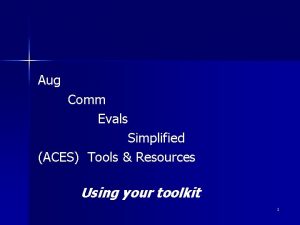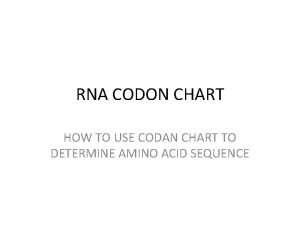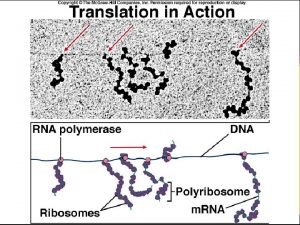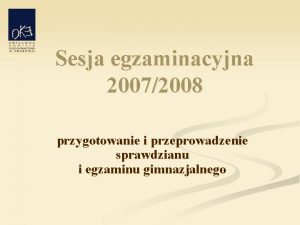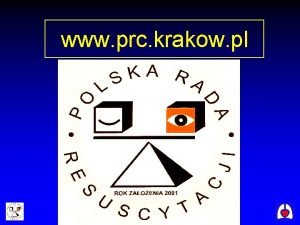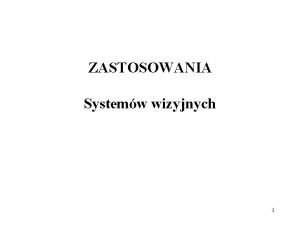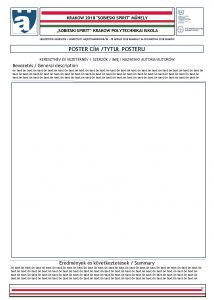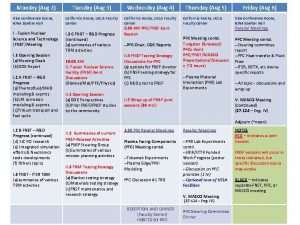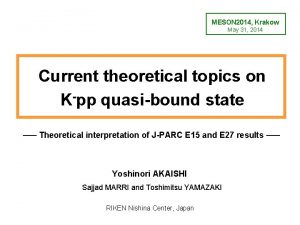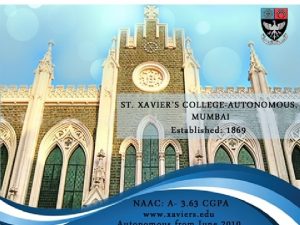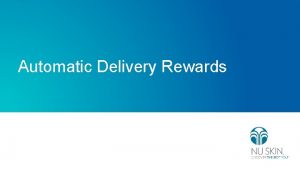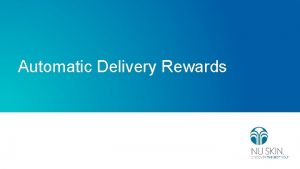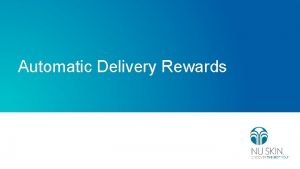Amrest Krakow Delivery 4 5 Aug 2014 session












- Slides: 12

Amrest – Krakow Delivery 4 & 5 Aug 2014 session th th

Summary of session Attendees Agenda Yum - Chris Drew - Finance Leader - Andy Goves - Operation coach - Natalia Pawlak - Learning zone coach Day 1 - Sample Product Validation Day 2 Amrest - KPI’s and communication - Monika Cyzy - District Coach - Training and daily tools to support - Magdalena Gisman - Ops Service Manager delivery - Agata Szczyglewska - Training manager - CER review - Marek Krysiak – CER coach - GES/GFP next steps - Tomasz Wawrzyn - Delivery Manager - Paweł Wojnowski – Area Coach - Trade Zones – Localising at store level - Marcin Płażynski - Market Planer

Day 1 – Product Validation Session focused on generating temperature and product quality data for multiple products within store. The following process was undertaken for each product tested: • Product cooked in one batch and taken to hot hold. Temperature taken at point of entry • At intervals in the hot hold (based on current product holding time), the product was taken out and placed into Delivery bag. • The product was removed from the Delivery bag at intervals to measure temperature and quality. Specific details of the test were: • Products tested – OR chicken, Strips (with foil packaging), Hot wings (Flat) and two Sandwiches. • Intervals of hold time in hot hold – 25%, 50%, 75%, 100% • Time intervals for product testing in Delivery bag (2. 5 mins, 7. 5 mins and 10 mins) Conditions for the testing: • Product held in the bottom half of the HC 900 (Temperature differential of upto 8 C from top half) • Product packaged separately • Delivery bags kept in store throughout time of testing • Products were packed individually into separate heated pouches so that temperature was not lost when opening the bag to take the temperature The Validation process can be found in the attached file. Delivery Product Validation V 4. xls

Results – Temperature testing

Observations – Core meat blocks Observations - All Products lost approx. 25 -28% of its temperature while being held in the HC 900 – bottom half (start to end of hold time) - Strips packed before 50% of its hold time achieved above 65 degrees at the end of 8 minutes in the pouch. - At 50% of hold time OR chicken and Hot wings fell below 65 degrees Takeaways - Am. Rest to undertake further testing using meal bundles and holding in various equipment - Validate the temperature of the equipment holding the product - Include blind consumer testing Vs fresh in freshly made

Observations – Sandwiches Observations - Grander – At 50% of hold time the required temperature was achieved at the end of 10 minutes in the heated pouch. - Twister – At 25% of Hold time the required temperature was not achieved at the end of 10 minutes in the heated pouch Takeaways - Validate the temperature of the equipment holding the product - Include blind consumer testing Vs fresh in freshly made

Day 2 – Review and next steps (1 of 2) The day was spent working through the following questions: The temperature and quality testing showed there is a limited period from product leaving fryer to consumer (either in Hot Hold or packaged travelling to customer). Longer hold time will equate to shorter delivery time and vice versa. What is the commercial sweet spot between the two intervals, ensuring the product quality our consumer receives across all products is to Dine in standard? – What further testing is required? – What scenarios do we want to review? – How do we improve the controlled testing? Can we involve NPD to continue? – Consumer group blind testing Theoretically proving the above system will deliver Dine in standard product is only as good as the reality on the ground. How do you accurately and consistently prove the reality on the ground today? How are you comfortable with compliance going forward? This should cover: – Do we have sufficient KPIs to measure time from Fryer to consumer at present, so we cannot test whether theory is being adhered to (and the ones you do have imply that 40% of product reaches the consumer below 65 c) – We don’t know with enough certainty what our consumers are thinking of us (How can we make GES available today (Short term solution) – What role does CER have? – Do we have sufficient training materials to support this? – Is our Trade Zone mapping appropriate for the reality on the Group

Day 2 – Review and next steps (2 of 2) The day was spent working through the following questions: How do we define a simple process to manage product in store based on delivery using a different shelf life? – A standard process that can apply to all stores – How do we reduce the risk of the team using product that is in time but not delivery time – How would this look with QPM?

Output from Day 2 Area of Focus Product Quality Outstanding Areas to action The temperature and quality testing showed there is a limited period from product leaving fryer to consumer (either in Hot Hold or packaged travelling to customer). Longer hold time will equate to shorter delivery time and vice versa. What is the commercial sweet spot between the two intervals, ensuring the product quality our consumer receives across all products is to Dine in standard? Next steps Arrange further validation session Validate all products including meat block and sandwiches. Various scenarios will be tested such as correct holding conditions (i. e. top half of HC 900 and various holding equipment). Also packed meals Vs individual product testing. Amrest will review whether this can be conducted in a suitable testing environment e. g. test kitchen Blind consumer testing To gather an understanding of the impact of taste and appearance Amrest will conduct blind test where consumer will be given various products and rate them not knowing how long they have been held Both results will be shared with Yum! Understand the Benefits of Yum! new Hot hold equipment Yum! To support using the new Hot hold equipment to understand if there is a benefit to the initial temperature throughout the hold time of the product. This will be reviewed against the results in Krakow. Target date 22 nd Aug 2014 Responsi ble Yum! - Andy

Output from Day 2 Area of Focus KPI’s GFP / GES Outstanding Areas to action Do we have sufficient KPIs to measure time from Fryer to consumer at present, so we cannot test whether theory is being adhered to (and the ones you do have imply that 40% of product reaches the consumer below 65 c) Target date Next steps As per KPI presentation Amrest will update Micros and KDS to include the below KPI’s. this will be a fusion style approach with bump bars Pack time Dispatch time (target 30 sec) Drive time Total in store time Total delivery time Amrest will also review as to weather a DT style display of live data can be implemented to support shift performance. We don’t know with enough Amrest to test GFP in 3 stores using an adapted short term process. certainty what our consumers are IT to update delivery receipts to include all required in thinking of us (How can we make Drivers will be trained to issue invitation GES available today (Short term Ensure survey includes delivery addition solution) Call back feedback form will also be updated to align with GFP questions and rating. This will be a shorter version but will support comparative data Meanwhile Magda will work on and finalise a long term solution Respon sible

Output from Day 2 Area of Focus CER Training Trade Zones Outstanding Areas to action What role does CER have in supporting operations and reviewing key delivery areas Do we have sufficient training materials to support this? Is our Trade Zone mapping appropriate for the reality on the Group Target date Next steps Respon sible Marek to share final updated delivery list of deviation to be reviewed. These will be reviewed on every CER with stores that have a delivery channel. Q 4 2014 – deviations will be recorded and coached but not deducted. Q 1 2015 – Deviations will be deducted Given these are not scored the deviations would need to be collected manually for review Any new additions or procedure will be updated into the training manuals Amrest will update all stores to reflect real life 8 minute drive times. Targeo will be used to complete this Amrest will also run the exercise to review how much impact this has Vs the current 10 minute drive time What % loss of trade zone coverage? What is impact of possible population coverage?

Output from Day 2 Area of Focus Outstanding Areas to action Operations This is based on potentially using 2 different hold times on product. I. e. delivery will only pack products under 50% of the original hold time. How do we define a simple process to manage product in store based on delivery using a different shelf life? Next steps Amrest to define a single process that works across all delivery stores. Amrest to share with Yum! to review and approve Training team to update training material to support this Target date Tbc Respon sible Yum! - Andy
 Micros amrest
Micros amrest Aug methionine start codon
Aug methionine start codon Aug comm device
Aug comm device Amino acid of aug
Amino acid of aug Transkripsjon og translasjon
Transkripsjon og translasjon Timeline ng el filibusterismo pagkakasunod sunod
Timeline ng el filibusterismo pagkakasunod sunod Pat root word
Pat root word Aug q
Aug q Components of ads accenture delivery suite
Components of ads accenture delivery suite Oke kraków obieg
Oke kraków obieg Prc.krakow
Prc.krakow Systemy wizyjne kraków
Systemy wizyjne kraków Na półkuli północnej pasaty przyjmują kierunek
Na półkuli północnej pasaty przyjmują kierunek


